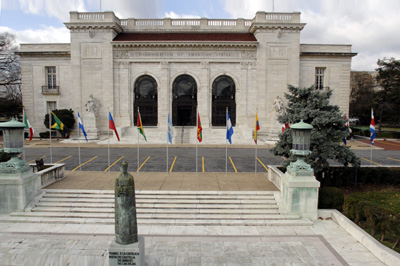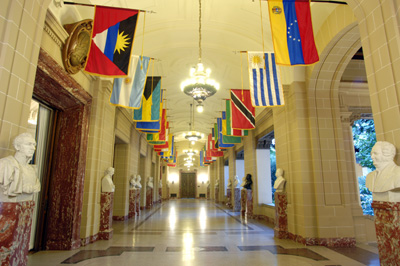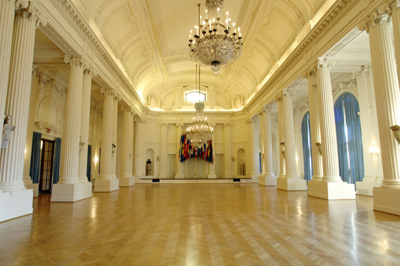- English
- Español
Briefings and Tours
About the Tour and Briefing Programs
OAS briefings are offered to diplomats, government officials, military officers, university faculty, policy analysts and students, as well as to the general public.
The briefings are given by the Director of the Department of Strategic Initiatives and Public Diplomacy and senior specialists from the various departments of the organization.
Briefings are tailored to the specific interests of the visiting groups, covering political, social, legal and economic issues in the Americas as well as the work of the organization.
Briefings include a tour of the Historical OAS Main Building and an overview of the organization.
OAS Main Building

When the OAS Building located at Seventeenth Street and Constitution Ave., N.W., Washington D.C., was completed in 1910, it was considered the architectural wonder of its time. Ninety-three years later, the building's tropical patio, marbled staircases and galleries, and monumental halls continue to delight the thousands of tourists and diplomats who visit the elegant structure every year. The building was designed and constructed to serve as the headquarters of what is today the world's oldest regional organization, the Organization of American States (OAS), an association of nations formed by 35 countries from the Americas and the Caribbean.
Bearing in mind the many cultures and societies that comprised the institution to be housed in the structure, its architects, Paul Cret and Albert Kelsey, set out to make the building an architectural symbol of the unity of the hemisphere by employing a harmonious combination of the major cultural influences found in the Organization's member states. While at first glance the building appears predominantly Spanish colonial in design, upon further inspection the visitor will perceive Native American, French, Portuguese, and English influences.
The Director General of what was then known as the Pan American Union, John
Barrett, said of the building: "This monumental intention is to give visible
expression to the ideas of unity, of solidarity, of amity that found
realization in the Union of American Republics... This is not only a palace,
but the spiritual home of the citizens of the 21 American republics" that
founded the Organization on April 14, 1890.
A statue of Queen Isabella of Spain is the first sight to greet the visitor to
the OAS Building. Located in front of the building on 17th street, it serves
as an artistic introduction to the history of the Americas before the visitor
enters the structure, described by Washington tour guides as one of the most
beautiful to be found in the nation's capital.
On the marble facade of the building, flanking the three monumental bronze
gates that decorate the arched portals, are two friezes depicting North and
South America. Here, the bald eagle of the north and the condor of the south
gaze at each other, standing watch over the principles of international
relations that guide the actions of the OAS. The words "Organization of
American States" are carved on the marble wall above the sculptured groups.
The name "Pan American Union" is inscribed on a reddish-gray panel above the
doorways leading into the House of the Americas.
The OAS Building, known throughout the region as "The House of the Americas",
has become more than a beautiful architectural statement. It has truly become
a lasting symbol of inter-American unity and understanding
The Patio

Upon entering the building, one is first struck by its magnificent proportions
and, above all, by the remarkable tropical patio, enclosed by a sliding glass
roof, that serves as a garden spot for rare tropical plants all year round.
Here can be found rubber, fig, coffee, and banana plants, as well as other
tropical plants bearing exotic flowers. The floor of the patio is made of red
tile decorated with black figures copied from Maya and Inca ruins.
Prominent among the lush vegetation of the patio is the historic "Peace
Tree", a hybrid of fig and rubber, planted by President William Howard
Taft during the building's dedication ceremonies in 1910.
The patio's focal point is a pink marble fountain adorned with Native American
figures, including snakes with flashing eyes and mouths that spurt water.
Surrounding the patio from above are the coats of arms of the original 21
member nations, interspersed with the names of important persons from the
region's history.
The Simon Bolivar

Beyond the Patio is the Simon Bolivar Room, where the Organization's Permanent Council meets. The Council is the political arm of the OAS and is comprised of the ambassadors of the OAS Member States. Modern in design, the chamber is equipped with simultaneous interpretation facilities for the four official languages of the OAS, Spanish, English, French and Portuguese.
Hall of Flags and Heroes

Having climbed the two marble staircases at either side of the patio, visitors find themselves in the Hall of Flags and Heroes. Here one may view the colorful flags of all the OAS Member States arranged in alphabetical order in Spanish, as well as busts of many national heroes, including George Washington, Simón Bolivar, José de San Martin, Benito Juarez and others.
Hall of the Americas

The elegant and magnificent Hall of the Americas with its impressive columns is 100 feet long, 65 feet wide, and 45 feet high, with stately white columns with Corinthian capitals, 24 of which correspond to the five entrances from the Hall of the Heroes. The room also features glittering crystal chandeliers by Tiffany and ornate stained glass windows.
This room is where the highest-ranking meetings of the inter-American system
take place. This is also where numerous Heads of State, including Pope John
Paul II, have addressed the Organization and where the historic Panama Canal
Treaties were signed in 1977.
The Aztec Garden & OAS Art Museum of the Americas

Looking beyond the Hall of the America's stained glass windows, the visitor can appreciate the beauty of the Aztec Garden below. The garden, with its statuary, reflecting pool, and greenery joins the OAS Building and can be reached from the broad terrace at the rear. The theme of the building continues here with Xochipilli, the Aztec God of Flowers, guarding a blue-tiled pool and with the OAS Art Museum of the Americas, which was formerly the official residence of the Organization's Secretary General.
Memorial Library
Until the late 80’s, the basement of the OAS building was home to the Columbus
Memorial Library, one of Washington's best information centers on the
Inter-American System, on Latin America and the Caribbean, and on the
inter-American relations in general.
The Tunnel

In the basement there is a tunnel connecting the OAS Building with its Administration Building two blocks away. The tunnel is decorated by a 200-yard long mural title "The Root of Peace", painted by the Uruguayan artist Carlos Paez Vilaró. This mural depicts various themes of peace and development in the Americas.


